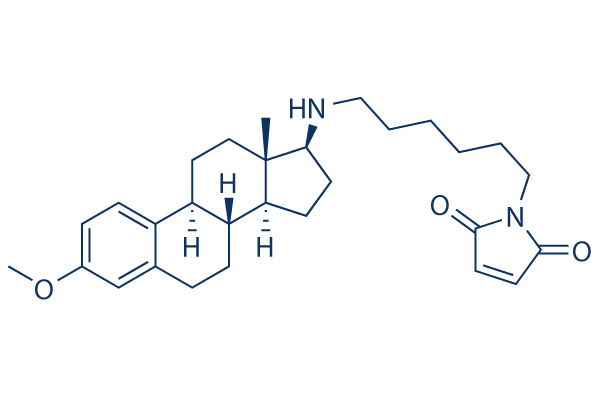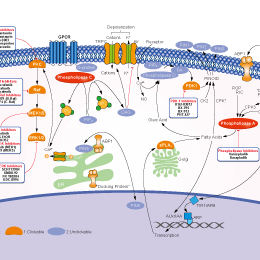
- 阻害剤
- 研究分野別
- PI3K/Akt/mTOR
- Epigenetics
- Methylation
- Immunology & Inflammation
- Protein Tyrosine Kinase
- Angiogenesis
- Apoptosis
- Autophagy
- ER stress & UPR
- JAK/STAT
- MAPK
- Cytoskeletal Signaling
- Cell Cycle
- TGF-beta/Smad
- 化合物ライブラリー
- Popular Compound Libraries
- Customize Library
- Clinical and FDA-approved Related
- Bioactive Compound Libraries
- Inhibitor Related
- Natural Product Related
- Metabolism Related
- Cell Death Related
- By Signaling Pathway
- By Disease
- Anti-infection and Antiviral Related
- Neuronal and Immunology Related
- Fragment and Covalent Related
- FDA-approved Drug Library
- FDA-approved & Passed Phase I Drug Library
- Preclinical/Clinical Compound Library
- Bioactive Compound Library-I
- Bioactive Compound Library-II
- Kinase Inhibitor Library
- Express-Pick Library
- Natural Product Library
- Human Endogenous Metabolite Compound Library
- Alkaloid Compound LibraryNew
- Angiogenesis Related compound Library
- Anti-Aging Compound Library
- Anti-alzheimer Disease Compound Library
- Antibiotics compound Library
- Anti-cancer Compound Library
- Anti-cancer Compound Library-Ⅱ
- Anti-cancer Metabolism Compound Library
- Anti-Cardiovascular Disease Compound Library
- Anti-diabetic Compound Library
- Anti-infection Compound Library
- Antioxidant Compound Library
- Anti-parasitic Compound Library
- Antiviral Compound Library
- Apoptosis Compound Library
- Autophagy Compound Library
- Calcium Channel Blocker LibraryNew
- Cambridge Cancer Compound Library
- Carbohydrate Metabolism Compound LibraryNew
- Cell Cycle compound library
- CNS-Penetrant Compound Library
- Covalent Inhibitor Library
- Cytokine Inhibitor LibraryNew
- Cytoskeletal Signaling Pathway Compound Library
- DNA Damage/DNA Repair compound Library
- Drug-like Compound Library
- Endoplasmic Reticulum Stress Compound Library
- Epigenetics Compound Library
- Exosome Secretion Related Compound LibraryNew
- FDA-approved Anticancer Drug LibraryNew
- Ferroptosis Compound Library
- Flavonoid Compound Library
- Fragment Library
- Glutamine Metabolism Compound Library
- Glycolysis Compound Library
- GPCR Compound Library
- Gut Microbial Metabolite Library
- HIF-1 Signaling Pathway Compound Library
- Highly Selective Inhibitor Library
- Histone modification compound library
- HTS Library for Drug Discovery
- Human Hormone Related Compound LibraryNew
- Human Transcription Factor Compound LibraryNew
- Immunology/Inflammation Compound Library
- Inhibitor Library
- Ion Channel Ligand Library
- JAK/STAT compound library
- Lipid Metabolism Compound LibraryNew
- Macrocyclic Compound Library
- MAPK Inhibitor Library
- Medicine Food Homology Compound Library
- Metabolism Compound Library
- Methylation Compound Library
- Mouse Metabolite Compound LibraryNew
- Natural Organic Compound Library
- Neuronal Signaling Compound Library
- NF-κB Signaling Compound Library
- Nucleoside Analogue Library
- Obesity Compound Library
- Oxidative Stress Compound LibraryNew
- Phenotypic Screening Library
- PI3K/Akt Inhibitor Library
- Protease Inhibitor Library
- Protein-protein Interaction Inhibitor Library
- Pyroptosis Compound Library
- Small Molecule Immuno-Oncology Compound Library
- Mitochondria-Targeted Compound LibraryNew
- Stem Cell Differentiation Compound LibraryNew
- Stem Cell Signaling Compound Library
- Natural Phenol Compound LibraryNew
- Natural Terpenoid Compound LibraryNew
- TGF-beta/Smad compound library
- Traditional Chinese Medicine Library
- Tyrosine Kinase Inhibitor Library
- Ubiquitination Compound Library
-
Cherry Picking
You can personalize your library with chemicals from within Selleck's inventory. Build the right library for your research endeavors by choosing from compounds in all of our available libraries.
Please contact us at [email protected] to customize your library.
You could select:
- 抗体
- 新製品
- お問い合わせ
U73122
U73122 is a potent phospholipase C (PLC) inhibitor, which reduces agonist-induced Ca2+ increases in platelets and PMN. U73122 potently inhibits human 5-lipoxygenase (5-LO).

CAS No. 112648-68-7
文献中Selleckの製品使用例(66)
製品安全説明書
現在のバッチを見る:
純度:
99.22%
99.22
U73122関連製品
シグナル伝達経路
Phospholipase (e.g. PLA)阻害剤の選択性比較
Cell Data
| Cell Lines | Assay Type | Concentration | Incubation Time | 活性情報 | PMID |
|---|---|---|---|---|---|
| human Jurkat cells | Function assay | Inhibition of human telomerase activity in human Jurkat cells by TRAP assay, IC50=0.2 μM | 24053596 | ||
| 他の多くの細胞株試験データをご覧になる場合はこちらをクリックして下さい | |||||
生物活性
| 製品説明 | U73122 is a potent phospholipase C (PLC) inhibitor, which reduces agonist-induced Ca2+ increases in platelets and PMN. U73122 potently inhibits human 5-lipoxygenase (5-LO). | |
|---|---|---|
| Targets |
|
| In Vitro | ||||
| In vitro |
U73122 significantly inhibits aggregation of human platelets induced by a variety of agonists, including collagen, thrombin, ADP, arachidonic acid, with IC50 of 1-5 μM. U-73122 (10 μM) inhibits the production of IP3 and the subsequent rapid increase in cytosolic Ca2+ induced by either thrombin or U-46619 through inhibiting hydrolysis of phosphatidyl[3H]inositol and phosphatldyl[3H]inosito1 4,5-bisphosphate catalyzed by a soluble fraction from platelets (Ki=9 and 40 μM, respectively). U-73122 inhibits thromboxane B production induced by collagen through inhibiting receptor-coupled mobilization of arachidonic acid. U73122 inhibits also FMLP-induced aggregation of human polymorphonuclear neutrophils and the associated production of IP3 and diacylglycerol. [1] U-73122 causes a concentration-dependent inhibition of C5a, FMLP, PAF and LTB4-induced MPO and B12-BP release from cyto-chalasin B-treated PMNs. The IC50 values are 60 (FMLP), 110 (LTB4), 115 (C5a) and 120 (PAF) nM for MPO release; and 105 (FMLP), 110 (LTB4), 120 (C5a) and 140 (PAY) nM for B12-BP release. U-73122 is also a potent inhibitor of superoxide anion production by cytochalasin B-treated PMNs activated with either C5a or FMLP with IC50 of 160 and 300 nM, respectively. U-73122 causes suppression of the rise in [Ca2+]i, IP3 production and DAG production in FMLP-stimulated PMNs with IC50 of 500 nM, 2 μM, and 2 μM, respectively. 3 μM U-73122 causes 100% inhibition of FMLP-induced GTPase activity. U-73122 causes a concentration-dependent inhibition of the FMLP-evoked association of PKC with the extractable particulate fraction of PMNs, but not a soluble preparation of PMN PKC. [2] U73122 significantly inhibits recombinant human PLC-β2, with an IC50 of ~6 μM. U73122 has little effect on PLC-β1, PLC-β3, or PLC-β4. U73122 reduces interleukin-8 and leukotriene B4-induced Ca2+ flux and chemotaxis in human neutrophils with IC50 of ~6 μM and ~5 μM, respectively. [3] 1 μM U73122 blocks bradykinin (BK)-induced increases in the intracellular free Ca2+ concentration in undifferentiated NG108-15 cell. The IC50 for a 20-min exposure is approximately 200 nM. 1 μM U73122 produces a small but significant increase in [Ca2+]i which results from Ca 2+ release from an intracellular store. In differentiated NG108-15 cells U73122 blocks completely depolarization-induced Ca2+ influx. In contrast, in DRG neurons U73122 inhibits only slightly voltage-sensitive Ca2+ channels. [4] U73122 is a relatively specific inhibitor of G-protein-mediated phospholipase C activation in pancreatic acini. U73122 inhibits phosphatidylinositol (PI) hydrolysis on stimulation with either cholecystokinin (by 81%) or carbachol (by 73%) at a maximal effect concentration of 10 μM. U73122 (10 μM) inhibits the increases in [Ca2+]i stimulated by high concentrations of secretagogues in fura-2-loaded acini. U73122 also inhibits the [Ca2+]i signal generated by directly stimulating G-proteins with sodium fluoride. U73122 rapidly inhibits the oscillating [Ca2+]i signal elicited by low concentrations of cholecystokinin or carbachol. [5] U73122 increases the activity of hPLCβ3 in a concentration-and time-dependent manner in a cell-free micellar system, with up to an 8-fold increase in enzyme activity and a EC50 of 13.6 μM. Activation of hPLCβ3 by U73122 requires covalent modification of cysteines. U73122 (10 μM) also activates hPLCγ1(>10-fold) and hPLCβ2(~2-fold); PLC δ1 is neither activated nor inhibited. [6] |
|||
|---|---|---|---|---|
| Kinase Assay | Phosphoinositide-specific phospholipase C activity assay | |||
| Assay mixtures (0.2 mL) contains assay buffer (without leupeptin), CaCl2 (an amount calculated to produce a Ca-EGTA buffer with the required free Ca2+ concentration), platelet soluble fraction (5-15 μg of protein) and 4 nmol of either phosphatidyl[3H]inositol or phosphatidyl[3H]inositol 4,5-bisphosphate. Substrata mixtures consists of either phosphatidyl[3H]inositol (3.4 Ci/mol) plus 1-pahnitoyl-2-oleoyl-sn-glycero-3-phosphoethanolamine (1:0.4 M ratio) or phosphatidyl[3H]inositol4,5-bisphosphate (7 Ci/mol) plus 1-palmitoyl 2-oleoyl-sn-giycero-3-phosphoethanolamine (1:4 M ratio). Substrate mixtures are prepared as l0× suspensions of small unilamellar vesicles by consonication of the lipids in assay buffer (Vibra Cell microprobe sonicator, 75 W, 2 times 60 sec). U-73122 is added to assay mixtures in 2 μL of DMSO. This amount of DMSO has a negligible effect on phospholipase C activity under these conditions. Assay mixtures are incubated in glass tubes at 37 ℃ for 10 min and then quenched with 1.6 mL of chloroform/rnethanol/HC1 (1 N) (108:108:25, by vol). After vigorous mixing and centrifugation (500 g for 10 min), a portion (0.7 mL) of the aqueous upper layer (0.9 mL) is transferred to a scintillation vial that contains 10 mL of ACS scintillation fluid. Tritium in water-soluble products (>90% being inositol phosphates) is measured by liquid scintillation spectrornetry. Phosphoinositide hydrolysis under these conditions never exceeds 10% of total added and proceeded at a constant rate throughout the incubation period. Blank values are determined from assay mixtures in which platelet soluble fraction is added after the stopping reagent. | ||||
| In Vivo | ||
| In Vivo |
U73122 (30 mg/kg i.p.) blocks swelling of rats hind paw by 65 and 80% at 1 and 3 h postcarrageenan challenge. U73122 (0.1 mg/mL) inhibits carrageenan-induced macrophage and lymphocyte accumulation into subcutaneous chambers in dogs by 65 and 74%, respectively. U73122 (30 mg/kg i.p.) totally inhibits the LPS-induced increase in macrophage and lymphocyte infiltration and prostaglandin E2 production (by 80%) in a mouse peritonitis model, and inhibits and 12- O-tetradecanoyl-phorbol-13-acetate-induced ear edema in mice. [3] |
|
|---|---|---|
| 動物実験 | 動物モデル | Swiss-Webster mic |
| 投与量 | 30 mg/kg | |
| 投与経路 | i.p. | |
化学情報
| 分子量 | 464.64 | 化学式 | C29H40N2O3 |
| CAS No. | 112648-68-7 | SDF | Download U73122 SDFをダウンロードする |
| Smiles | CC12CCC3C(C1CCC2NCCCCCCN4C(=O)C=CC4=O)CCC5=C3C=CC(=C5)OC | ||
| 保管 | |||
|
In vitro |
DMSO : 93 mg/mL ( (200.15 mM); 吸湿したDMSOは溶解度を減少させます。新しいDMSOをご使用ください。) Water : Insoluble Ethanol : Insoluble |
モル濃度計算器 |
|
in vivo Add solvents to the product individually and in order. |
投与溶液組成計算機 | ||||
実験計算
投与溶液組成計算機(クリア溶液)
ステップ1:実験データを入力してください。(実験操作によるロスを考慮し、動物数を1匹分多くして計算・調製することを推奨します)
mg/kg
g
μL
匹
ステップ2:投与溶媒の組成を入力してください。(ロット毎に適した溶解組成が異なる場合があります。詳細については弊社までお問い合わせください)
% DMSO
%
% Tween 80
% ddH2O
%DMSO
%
計算結果:
投与溶媒濃度: mg/ml;
DMSOストック溶液調製方法: mg 試薬を μL DMSOに溶解する(濃度 mg/mL, 注:濃度が当該ロットのDMSO溶解度を超える場合はご連絡ください。 )
投与溶媒調製方法:Take μL DMSOストック溶液に μL PEG300,を加え、完全溶解後μL Tween 80,を加えて完全溶解させた後 μL ddH2O,を加え完全に溶解させます。
投与溶媒調製方法:μL DMSOストック溶液に μL Corn oil,を加え、完全溶解。
注意:1.ストック溶液に沈殿、混濁などがないことをご確認ください;
2.順番通りに溶剤を加えてください。次のステップに進む前に溶液に沈殿、混濁などがないことを確認してから加えてください。ボルテックス、ソニケーション、水浴加熱など物理的な方法で溶解を早めることは可能です。
技術サポート
ストックの作り方、阻害剤の保管方法、細胞実験や動物実験の際に注意すべき点など、製品を取扱う時に問い合わせが多かった質問に対しては取扱説明書でお答えしています。
他に質問がある場合は、お気軽にお問い合わせください。
* 必須
Tags: U73122を買う | U73122 ic50 | U73122供給者 | U73122を購入する | U73122費用 | U73122生産者 | オーダーU73122 | U73122化学構造 | U73122分子量 | U73122代理店

